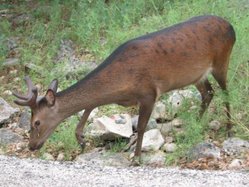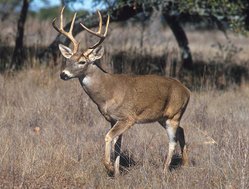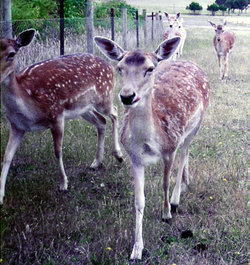Deer
A deer is a ruminant mammal belonging to the family Cervidae. A number of broadly similar animals, from related families within the order Artiodactyla, are often also called deer. more...
Depending on the species, male deer are called stags, harts, bucks or bulls, and females are called hinds, does or cows. Young deer are called calves or fawns (not to be confused with fauns, a kind of nature spirit). Hart is an expression for a stag, particularly a Red Deer stag past its fifth year. It is not commonly used, but an example is in Shakespeare's "Romeo and Juliet" when Tybalt refers to the brawling Montagues and Capulets as hartless hinds. "The White Hart" and "The Red Hart" are common English pub names.
Deer are widely distributed, with representatives in all continents except Australia, Antarctica, and Africa. Australia does have six introduced species of deer that have established sustainable wild populations from Acclimatisation Society releases in the 19th Century. These are Fallow Deer, Red Deer, Sambar Deer, Hog Deer, Rusa deer, and Chital Deer. Although exotic to the continent, environmental factors restrict their ranges to habitable patches, thereby preventing any one species from becoming a serious pest. Red Deer introduced into New Zealand in early 1900s (a gift from United States President Theodore Roosevelt) have been largely domesticated in deer farms since the late 1960s and are common farm animals there now.
Deer differ from other ruminants in that they have antlers instead of horns. Antlers are bony growths that develop each year (usually in summer) and, in general, it is only male deer that develop them (although there are exceptions). A young buck's first pair of antlers grow from two tiny bumps on their head that they have had from birth. The antlers grow wrapped in a thick layer of velvet and remain that way for one month, until the bone inside is hard; later the velvet is shed. During the mating season, bucks use their antlers to fight one another for mates. The two bucks circle each other, bend back their legs, lower their heads, and charge.
A doe usually generally has one or two fawns at a time (triplets, while not unusual, are much more infrequent). The gestation period is anywhere between 160 days (just over 5 months) in the musk deers to ten months for the roe deer. Most fawns are born with their fur covered with white spots, though they lose their spots once they get older (excluding the Fallow Deer who keeps its spots for life). In the first twenty minutes of a fawn's life, the fawn begins to take its first steps. Its mother licks it clean until it is almost free of scent, so predators will not find it. Its mother leaves often, and the fawn does not like to be left behind. Sometimes its mother must gently push it down with her foot. The fawn stays hidden in the grass for one week until it is strong enough to walk with its mother. After two days, a fawn is able to walk, and by three weeks it can run and jump. The fawn and its mother stay together for about one year. They then go their seperate ways. A male usually never sees his mother again, but females sometimes come back with their own fawns and form small herds.
Read more at Wikipedia.org




